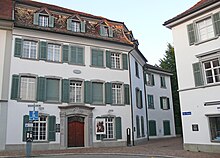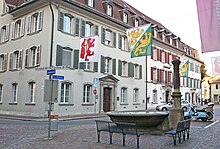Bernerhaus (Haus zur Gedult)
The Bernerhaus with the house name Haus zur Gedult is part of a row of houses that closed off the former district of the old town of Frauenfeld to the northwest. The house was once the legation house of the Old Confederation and the seat of the Bernese professional representatives at the time when the Canton of Thurgau was subject to the Confederation. Today the building houses the art association with its collection of paintings on its ground floor. There are apartments on the first floor, the other two floors are rented to various institutions.
history
The history of the Bernerhaus is closely intertwined with the fate of the row of houses which, as the city wall, formed the north-western end of the inner city district of Frauenfeld, as it existed until the city fire of July 9, 1771. The row of houses once comprised ten houses, all of which fell victim to the aforementioned city fire. The two beneficiary houses of the St. George and St. Michael chaplains in front of the St. Nicholas Church formed the north-eastern end. They were separated by Zürcherstrasse, which at this point leaves the city of Frauenfeld to the east through the Obertor. Next to it were the “Zur Kronen” inn, the narrow and low dwellings of the bricklayer Fehr and another building that belonged to the Kronenwirt. At the ridge height of the crown, the adjoining house swung up again to the "Palme", property of Councilor Alberic Locher von Freudenberg, and next to it was the Bern embassy house, the "Haus zur Gedult". As can still be seen in today's Bernerhaus, its front was angled towards Obergasse and in this, in itself windowless part of the facade, only had a stately arched door as the only access to the Bern property. In the back yard a horse stable pushed itself against the ditch and garden side between the Bernerhaus and the next following little house of the widow Wüst, which leaned against the hipped free gable side of the Bernerhaus. The north-western end of this entire former city wall was formed by a house that served the St. Katharinapfründe and the Catholic school. Of all these houses on Obergasse - today called Bankplatz - the Catholic schoolhouse was no longer rebuilt. Today the property forms the garden of the Bernerhaus.
After the fire and the reconstruction of the building, the property owners “Kronen” and “Palme” were able to secure the fire sites of the properties sandwiched between them. The Bernerhaus took over the fire place of the widow Wüst, leaving three of the seven former property owners, who could now be rebuilt larger and more stately. The beneficiary houses, located on the northwest corner at Obertor, were rebuilt, but had to be cut from the road construction in 1840, and in 1904 they gave way to the new building of the Catholic Church.
The Bernerhaus takes its name from the time when it was used as accommodation for the ambassadors of honor - or lords of the syndicate, as they were called. In 1460 the Landgraviate of Thurgau was conquered by the seven federal locations of Zurich, Lucerne, Uri, Schwyz, Unterwalden, Zug and Glarus. As a result, this “common rule” had to be administered, governed and judged, which was initially ensured by federal bailiffs, in which the estates took turns. After the Second Villmerger War in 1712, the Reformed cantons forced a new composition of the ruling places in the German common bailiwicks , which also included the majority Reformed Thurgau. The administration within the Old Confederation was therefore incumbent on the "VIII Old Places", which also included the Bern estate, although it did not take part in the conquest.
From 1713 to 1798 the representatives of the federal estates met regularly in Frauenfeld. Accommodation was provided either by private accommodation or guest houses rented for the duration of the conference, or by floors or entire houses rented all year round. As a powerful stand, the representatives of Bern had to be accommodated in a grand manner. For the duration of the legation, the representatives of a class did not travel alone, but brought their own secretaries, often horses and wagons, with them. The Bernese had probably moved into their quarters in the “Zur Gedult” house on Obergasse by 1757 at the latest, which at the time of the fire belonged to Johann Peter, Magdalena and Dorothea Mörikofer and Mrs. Cleopha Barbar, nee Schobinger.
With the reconstruction of the new row of houses there was real competition between the house owners on the one hand and the "Stadt Frauenfeld" on the other. It was apparently a lucrative business to accommodate the gentlemen, because not only were they able to pay on time, but they also came every year on the days around St Peter and Paul Day on June 29th. In addition, it became apparent that after the fire, which not only hit the row of houses in the Bernerhaus, many homeowners no longer wanted to build their houses in the narrow old urban area, but preferred to move to the suburbs. Here the land was cheaper. So suddenly several houses were empty, which made the situation even worse for those who remained.
This resulted in real price and supply wars between the better-off and nobler homeowners, with the civic community, which held the city administration, also safeguarding their interests. The confederates could have taken full advantage of the situation, but they did not. Rather, they were looking for a mutually compatible solution. The people of Zurich offered the city help for the orderly reconstruction, which the Frauenfeld citizens gratefully accepted. When the Bernerhaus was rebuilt in 1774, the Mörikofer siblings offered the Bern estate to lodge and entertain its honorary ambassadors, which the Bernese authorities accepted on March 31, 1774 in a provisionally positive manner. The Mörikofern were even "granted" a building loan of 5500 guilders on August 31 of the same year. This is probably not least because the property had been pledged to the Bern estate before the fire. It was feared, not without good reason, that the debtor Mörikofer would hardly ever be able to pay off the pledge if one turned to another property, albeit a cheaper one.
The same question arose for all stands, rent or buy. Ultimately, the more affluent among the class members decided to stay permanently, which is why the individual houses got their names, such as Luzernerhaus or Zürcherhaus. At that time, permanent residence meant that the premises were specially prepared and furnished for the "ambassadors". This could include colored curtains, wallpaper, and colored walls. If the stables were in the same rental property, as was the case in the Bernerhaus, then that had its corresponding price.
literature
- Albert Knoepfli : The Bernerhaus in Frauenfeld a commemorative publication on the occasion of its exterior renovation in 1964/65; ²taken right there
- Albert Knoepfli: The Monuments of the Canton of Thurgau Volume 1 Frauenfeld District, Society for Swiss Art History, Basel 1950 (= Art Monuments of Switzerland, Volume 23) DNB 750089156.
See also
Web links
Individual evidence
- ↑ Frauenfeld is in the picture - St.Galler Tagblatt Online. In: tagblatt.ch. Retrieved July 3, 2015 .
Coordinates: 47 ° 33 '24.8 " N , 8 ° 53' 55.6" E ; CH1903: seven hundred and nine thousand eight hundred ninety-five / 268374


